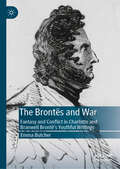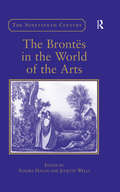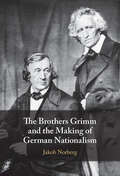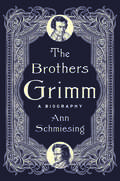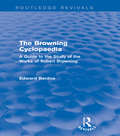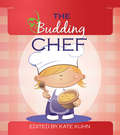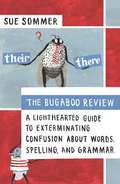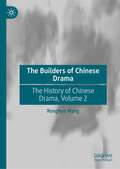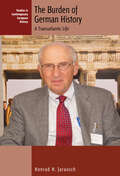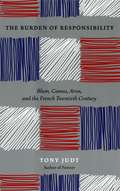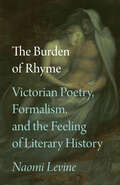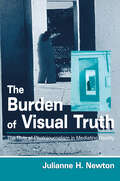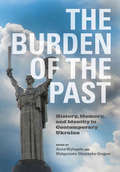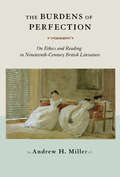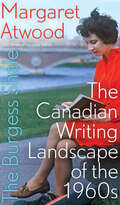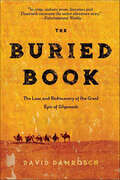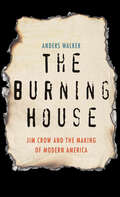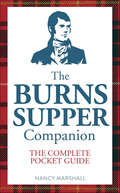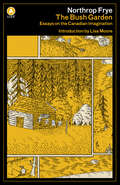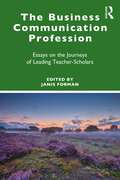- Table View
- List View
The Brontës and War: Fantasy and Conflict in Charlotte and Branwell Brontë’s Youthful Writings
by Emma ButcherThis book explores the representations of militarisim and masculinity in Charlotte and Branwell Brontë’s youthful writings. It offers insight into how the siblings understood and reimagined conflict (both local and overseas) and its emotional legacies whilst growing up in early-nineteenth-century Britain. Their writings shed new light on a period little discussed by social and military historians, providing not only a new approach to Brontë Studies, but also acting as a familial case study for how the media captivated and enticed the public imagination.
The Brontës and the Idea of the Human: Science, Ethics, and the Victorian Imagination (Cambridge Studies in Nineteenth-Century Literature and Culture #115)
by Alexandra LewisWhat does it mean to be human? The Brontë novels and poetry are fascinated by what lies at the core - and limits - of the human. The Brontës and the Idea of the Human presents a significant re-evaluation of how Charlotte, Emily, and Anne Brontë each responded to scientific, legal, political, theological, literary, and cultural concerns in ways that redraw the boundaries of the human for the nineteenth century. Proposing innovative modes of approach for the twenty-first century, leading scholars shed light on the relationship between the role of the imagination and new definitions of the human subject. This important interdisciplinary study scrutinises the notion of the embodied human and moves beyond it to explore the force and potential of the mental and imaginative powers for constructions of selfhood, community, spirituality, degradation, cruelty, and ethical behaviour in the nineteenth century and its fictional worlds.
The Brontës in the World of the Arts (The Nineteenth Century Series)
by Juliette Wells Sandra HaganAlthough previous scholarship has acknowledged the importance of the visual arts to the Brontës, relatively little attention has been paid to the influence of music, theatre, and material culture on the siblings' lives and literature. This interdisciplinary collection presents new research on the Brontës' relationship to the wider world of the arts, including their relationship to the visual arts. The contributors examine the siblings' artistic ambitions, productions, and literary representations of creative work in both amateur and professional realms. Also considered are re-envisionings of the Brontës' works, with an emphasis on those created in the artistic media the siblings themselves knew or practiced. With essays by scholars who represent the fields of literary studies, music, art, theatre studies, and material culture, the volume brings together the strongest current research and suggests areas for future work on the Brontës and their cultural contexts.
The Brothers Grimm and the Making of German Nationalism
by Jakob NorbergIn the first comprehensive English-language portrait of Jacob and Wilhelm Grimm as political thinkers and actors, Jakob Norberg reveals how history's two most famous folklorists envisioned the role of literary and linguistic scholars in defining national identity. Convinced of the political relevance of their folk tale collections and grammatical studies, the Brothers Grimm argued that they could help disentangle language groups from one another, redraw the boundaries of states in Europe, and counsel kings and princes on the proper extent and character of their rule. They sought not only to recover and revive a neglected native culture for a contemporary audience, but also to facilitate a more harmonious and enduring relationship between the traditional political elite and an emerging national collective. Through close historical analysis, Norberg reconstructs how the Grimms wished to mediate between sovereigns and peoples, politics and culture. This title is also available as Open Access on Cambridge Core.
The Brothers Grimm: A Biography
by Ann SchmiesingThe first English-language biography in over fifty years to tell the full, vibrant story of Jacob and Wilhelm Grimm, known to history as the Brothers Grimm &“Ann Schmiesing . . has brought the brothers to life in their fullness.&”—Dominic Green, Wall Street Journal &“Magisterial.&”—Kirkus Reviews More than two hundred years ago, the German brothers Jacob Grimm (1785–1863) and Wilhelm Grimm (1786–1859) published a collection of fairy tales that remains famous the world over. It has been translated into some 170 languages—more than any other German book—and the Brothers Grimm are among the top dozen most translated authors in the world. In addition to collecting tales, the Grimms were mythographers, linguists, librarians, civil servants, and above all the closest of brothers, but until now, the full story of their lifelong endeavor to preserve and articulate a German cultural identity has not been well known. Drawing on deep archival research and decades of scholarship, Ann Schmiesing tells the affecting story of how the Grimms&’ ambitious projects gave the brothers a sense of self-preservation through the atrocities of the Napoleonic Wars and a series of personal losses. They produced a vast corpus of work on mythology and medieval literature, embarked on a monumental German dictionary project, and broke scholarly ground with Jacob&’s linguistic discovery known as Grimm&’s Law. Setting their story against a rich historical backdrop, Schmiesing offers a fresh consideration of the profound and yet complicated legacy of the Brothers Grimm.
The Brothers Grimm: From Enchanted Forests to the Modern World
by Jack ZipesMost of the fairy tales that we grew up with we know thanks to the Brothers Grimm. Jack Zipes, one of our surest guides through the world of fairy tales and their criticism, takes behind the romantics mythology of the wandering brothers. Bringing to bear his own critical expertise, as well as new biographical information, Zipes examines the interaction between the Grimms' lives and their work. He reveals the Grimms' personal struggle to overcome social prejudice and poverty, as well as their political efforts - as scholars and civil servant - toward unifying the German states. By deftly interweaving the social, political, and personal elements of the lives of the Brothers Grimm, Zipes rescues them from sentimental obscurity. No longer figures in fairy tale, the Brothers Grimm emerge as powerful creators, real men who established the fairy tale as one of our great literary institutions. Part biography, part critical assessment, part social history, the Brothers Grimm provides a complex and very real story about fairy tales and the modern world.
The Browning Cyclopaedia: A Guide to the Study of the Works of Robert Browning (Routledge Revivals)
by Edward BerdoeRobert Browning, the great Victorian poet, is often claimed to be hard to understand, largely on account of the obscurity of his language, the complexity of his thought, and his poetic style. The Browning Cyclopaedia, first published in 1891, presents an exposition of the prominent ideas of each poem, as well as its tone, its sources – historical, legendary or fanciful – and a glossary of every difficult word or allusion which might obscure the poem’s meaning. This volume remains indispensable for students of Robert Browning, as well as those interested in the general aesthetic climate of Victorian poetry.
The Budding Chef
by Kate KuhnCurious kids will delight in the 50 fun-filled recipes in The Budding Chef! Full of great ways for parents and their budding chefs to have fun together, this introduction to cooking is brimming with kitchen adventures and is perfect for kids aged 3 to 6. The easy-to-follow instructions and easy-to-find ingredients helps parents share their love of cooking in kid-friendly ways while creating special moments that they--and their child--will cherish forever. With a cup of wonder, a teaspoon of laughter, and a scoop of fun, these recipes bring parents and children together to share magical moments!
The Buffalo Century: Vāñcheśvara Dīkṣita’s Mahiṣaśatakam: A Political Satire for All Centuries
by Kesavan VeluthatThe Buffalo Century is a keen exploration of satire and its role in society and politics. Written in praise of a buffalo, Vāñcheśvara Dīkṣita’s Mahiṣaśatakam is timeless in its treatment of power, and its subversion. In resurrecting eighteenth-century Tanjore for the modern reader, Kesavan Veluthat lifts the poem beyond its immediate literary context and situates it in a contemporary global political setting. Presenting a modern English translation along with the Sanskrit text, this work provides a fare that is as rich in double entendre as it is in its onomatopoeic metaphors. A literary triumph and the voice of an age, this book will be a key text for students and scholars of history, political science, sociology, literature, especially Sanskrit and comparative, and cultural studies.
The Buffalo Century: Vāñcheśvara Dīkṣita’s Mahiṣaśatakam: A Political Satire for All Centuries
by Kesavan VeluthatThe Buffalo Century is a keen exploration of satire and its role in society and politics. Written in praise of a buffalo, Vāñcheśvara Dīkṣita’s Mahiṣaśatakam is timeless in its treatment of power, and its subversion. In resurrecting eighteenth-century Tanjore for the modern reader, Kesavan Veluthat lifts the poem beyond its immediate literary context and situates it in a contemporary global political setting. Presenting a modern English translation along with the Sanskrit text, this work provides a fare that is as rich in double entendre as it is in its onomatopoeic metaphors. A literary triumph and the voice of an age, this book will be a key text for students and scholars of history, political science, sociology, literature, especially Sanskrit and comparative, and cultural studies.
The Bugaboo Review
by Sue SommerFor years, high school English teacher Sue Sommer has given her students a photocopied edition of The Bugaboo Review. Filled with fun ways to remember and correct the most common pitfalls in language, the Review is legendary at her school. Because it's so accessible and easy to use, parents have requested copies, and the friends of parents, not to mention past students who have worn out their copies but want to take the Review with them into their academic, professional, and everyday lives. With the help of cartoon characters Bug and Boo, Sommer lays out the rules and troublesome words that ?ummox our word processors and email programs. Colorful examples and artful mnemonics help readers painlessly learn and remember it all -- including the pronunciation of befuddling words. This is ideal for students of all ages -- and also for anyone seeking an A in all their written and oral communications.
The Builders of Chinese Drama: The History of Chinese Drama, Volume 2
by Ronghua WangThis book provides a comprehensive overview of influential and popular Chinese drama actors and actresses, innovative directors, and emerging playwrights. It also offers insights into the features of Chinese stage design and the most prominent theatres in China, highlighting their role in the development of Chinese drama. Additionally, it provides a detailed description of Chinese audiences and their interactions with theatres. Furthermore, it provides a comprehensive overview of the major debates and discussions within the critical community surrounding Chinese drama.
The Burden of German History: A Transatlantic Life (Studies in Contemporary European History #28)
by Konrad H. JarauschAs one of the leading historians of Modern Europe and an internationally acclaimed scholar for the past five decades, Konrad H. Jarausch presents a sustained academic reflection on the post-war German effort to cope with the guilt of the Holocaust amongst a generation of scholars too young to have been perpetrators. Ranging from his war-time childhood to Americanization as a foreign student, from his development as a professional historian to his directorship of the Zentrum für Zeithistorische Forschung and concluding with his mentorship of dozens of PhDs, The Burden of Germany History reflects on the emergence of a self-critical historiography of a twentieth-century Germany that was wrestling with the responsibility for war and genocide. This partly professional and partly personal autobiography explores a wide range of topics including the development of German historiography and its methodological debates, the interdisciplinary teaching efforts in German studies, and the role of scholarly organizations and institutions.
The Burden of Responsibility: Blum, Camus, Aron, and the French Twentieth Century
by Tony JudtUsing the lives of the three outstanding French intellectuals of the twentieth century, renowned historian Tony Judt offers a unique look at how intellectuals can ignore political pressures and demonstrate a heroic commitment to personal integrity and moral responsibility unfettered by the difficult political exigencies of their time. Through the prism of the lives of Leon Blum, Albert Camus, and Raymond Aron, Judt examines pivotal issues in the history of contemporary French society—antisemitism and the dilemma of Jewish identity, political and moral idealism in public life, the Marxist moment in French thought, the traumas of decolonization, the disaffection of the intelligentsia, and the insidious quarrels rending Right and Left. Judt focuses particularly on Blum's leadership of the Popular Front and his stern defiance of the Vichy governments, on Camus's part in the Resistance and Algerian War, and on Aron's cultural commentary and opposition to the facile acceptance by many French intellectuals of communism's utopian promise. Severely maligned by powerful critics and rivals, each of these exemplary figures stood fast in their principles and eventually won some measure of personal and public redemption. Judt constructs a compelling portrait of modern French intellectual life and politics. He challenges the conventional account of the role of intellectuals precisely because they mattered in France, because they could shape public opinion and influence policy. In Blum, Camus, and Aron, Judt finds three very different men who did not simply play the role, but evinced a courage and a responsibility in public life that far outshone their contemporaries. "An eloquent and instructive study of intellectual courage in the face of what the author persuasively describes as intellectual irresponsibility."—Richard Bernstein, New York Times
The Burden of Rhyme: Victorian Poetry, Formalism, and the Feeling of Literary History
by Naomi LevineA major new account of Victorian poetry and its place in the field of literary studies. The Burden of Rhyme shows how the nineteenth-century search for the origin of rhyme shaped the theory and practice of poetry. For Victorians, rhyme was not (as it was for the New Critics, and as it still is for us) a mere technique or ahistorical form. Instead, it carried vivid historical fantasies derived from early studies of world literature. Naomi Levine argues that rhyme’s association with the advent of literary modernity and with a repertoire of medievalist, Italophilic, and orientalist myths about love, loss, and poetic longing made it a sensitive historiographic instrument. Victorian poets used rhyme to theorize both literary history and the most elusive effects of aesthetic form. This Victorian formalism, which insisted on the significance of origins, was a precursor to and a challenge for twentieth-century methods. In uncovering the rich relationship between Victorian poetic forms and a forgotten style of literary-historical thought, The Burden of Rhyme reveals the unacknowledged influence of Victorian poetics—and its repudiation—on the development of modern literary criticism.
The Burden of Visual Truth: The Role of Photojournalism in Mediating Reality (Routledge Communication Series)
by Julianne NewtonAs the visual component of contemporary media has overtaken the verbal, visual reportage has established a unique and extremely significant role in 21st-century culture. Julianne Newton has prepared this comprehensive analysis of the development of the role of visual reportage as a critical player in the evolution of our understanding of ourselves, others, and the world. The Burden of Visual Truth offers a first assessment of the role of visual journalism within the context of the complex, cross-disciplinary pool of literature and ideas required for synthesis. Newton approaches the subject matter from several perspectives, examining the theoretical and ideological bases for visual truth, particularly as conveyed by the news media, and applying relevant research on photojournalism and reality imagery to contemporary newspaper, broadcast, and internet professional practice. She extends visual communication theory by proposing an ecology of the visual for 21st century life and developing a typology of human visual behavior. Scholars in visual studies, media studies, journalism, nonverbal communication, cultural history, and psychology will find this analysis invaluable as a comprehensive base for studying reality imaging and human visual behavior. The volume also is appropriate for journalism and media studies coursework at the undergraduate and graduate levels. With its conclusions about the future of visual reportage, The Burden of Visual Truth also will be compelling reading for journalism and mass communication professionals concerned with improving media credibility and maintaining a significant course for journalism in the 21st century. For all who seek to understand the role of visual media in the formation of their views of the world and of their own identities, this volume is a must-read.
The Burden of the Past: History, Memory, and Identity in Contemporary Ukraine
by Anna Wylegała and Małgorzata Głowacka-GrajperEssays on how chaos, totalitarianism, and trauma have shaped Ukraine’s culture: “A milestone of the scholarship about Eastern European politics of memory.” —Wulf Kansteiner, Aarhus UniversityIn a century marked by totalitarian regimes, genocide, mass migrations, and shifting borders, the concept of memory in Eastern Europe is often synonymous with notions of trauma. In Ukraine, memory mechanisms were disrupted by political systems seeking to repress and control the past in order to form new national identities supportive of their own agendas. With the collapse of the Soviet Union, memory in Ukraine was released, creating alternate visions of the past, new national heroes, and new victims. This release of memories led to new conflicts and “memory wars.”How does the past exist in contemporary Ukraine? The works collected in The Burden of the Past focus on commemorative practices, the politics of history, and the way memory influences Ukrainian politics, identity, and culture. The works explore contemporary memory culture in Ukraine and the ways in which it is being researched and understood. Drawing on work from historians, sociologists, anthropologists, psychologists, and political scientists, the collection represents a truly interdisciplinary approach. Taken together, the groundbreaking scholarship collected in The Burden of the Past provides insight into how memories can be warped and abused, and how this abuse can have lasting effects on a country seeking to create a hopeful future.
The Burdens of Perfection: On Ethics and Reading in Nineteenth-Century British Literature
by Andrew H. MillerLiterary criticism has, in recent decades, rather fled from discussions of moral psychology, and for good reasons, too. Who would not want to flee the hectoring moralism with which it is so easily associated-portentous, pious, humorless? But in protecting us from such fates, our flight has had its costs, as we have lost the concepts needed to recognize and assess much of what distinguished nineteenth-century British literature. That literature was inescapably ethical in orientation, and to proceed as if it were not ignores a large part of what these texts have to offer, and to that degree makes less reasonable the desire to study them, rather than other documents from the period, or from other periods.Such are the intuitions that drive The Burdens of Perfection, a study of moral perfectionism in nineteenth-century British culture. Reading the period's essayists (Mill, Arnold, Carlyle), poets (Browning and Tennyson), and especially its novelists (Austen, Dickens, Eliot, and James), Andrew H. Miller provides an extensive response to Stanley Cavell's contribution to ethics and philosophy of mind. In the process, Miller offers a fresh way to perceive the Victorians and the lingering traces their quests for improvement have left on readers.
The Burgess Shale: The Canadian Writing Landscape of the 1960s (The CLC Kreisel Lecture Series)
by Margaret Atwood“Atwood provides a window into her own early writing days . . . a treasure for readers interested in Canadian literature because this is where it all began.” —Prairie Fire Review of Books“The outburst of cultural energy that took place in the 1960s was in part a product of the two decades that came before. It’s always difficult for young people to see their own time in perspective: when you’re in your teens, a decade earlier feels like ancient history and the present moment seems normal: what exists now is surely what has always existed.”In this short work, Margaret Atwood, author of The Handmaid’s Tale and “Canada’s most famous writer” (The New Yorker), compares the Canadian literary landscape of the 1960s to the Burgess Shale, a geological formation that contains the fossils of many strange prehistoric life forms. The Burgess Shale is not entirely about writing itself, however: Atwood also provides some insight into the meager writing infrastructure of that time, taking a lighthearted look at the early days of the institutions we take for granted today—from writers’ organizations, prizes, and grant programs to book tours and festivals.“Allows the reader a brief glimpse into the mind of a great writer and her perspective and experience living through what would now seem to many the Stone Age of the Canadian writing scene . . . invaluable and very readable.” —Canadian Literature
The Buried Book: The Loss and Rediscovery of the Great Epic of Gilgamesh
by David DamroschA “lively and accessible” history of the ancient Epic of Gilgamesh, and its sensational rediscovery in the nineteenth century (The Boston Sunday Globe).Composed in Middle Babylonia around 1200 BCE, The Epic of Gilgamesh foreshadowed later stories that would become as fundamental as any in human history: the Bible, Homer, The Thousand and One Nights. But in 600 BCE, the clay tablets that bore the story were lost—buried beneath ashes and ruins when the library of the wild king Ashurbanipal was sacked in a raid.The Buried Book begins with the rediscovery of the forgotten epic and its deciphering in 1872 by George Smith, a brilliant self-taught linguist who created a sensation—and controversy—when he discovered Gilgamesh among the thousands of tablets in the British Museum’s collection. From there the story goes backward in time, all the way to Gilgamesh himself. Damrosch reveals the story as a literary bridge between East and West: a document lost in Babylonia, discovered by an Iraqi, decoded by an Englishman, and appropriated in novels by both Philip Roth and Saddam Hussein. This is an illuminating, fast-paced tale of history as it was written, stolen, lost, and—after 2,000 years, countless battles, fevered digs, conspiracies, and revelations—finally found.“Damrosch creates vivid portraits of archaeologists, Assyriologists, and ancient kings, lending his history an almost novelistic sense of character. [He] has done a superb job of bringing what was buried to life.” —The New York Times Book Review“As astounding as the content of the Epic of Gilgamesh in which the questing hero travels to the underworld and back . . . superb and engrossing.” —Booklist (starred review)“Damrosch’s fascinating literary sleuthing will appeal to scholars and lay readers alike.” —Publishers Weekly (starred review)
The Burning House: Jim Crow and the Making of Modern America
by Anders WalkerA startling and gripping reexamination of the Jim Crow era, as seen through the eyes of some of the most important American writers"Walker has opened up a fresh way of thinking about the intellectual history of the South during the civil-rights movement."—Robert Greene, The NationIn this dramatic reexamination of the Jim Crow South, Anders Walker demonstrates that racial segregation fostered not simply terror and violence, but also diversity, one of our most celebrated ideals. He investigates how prominent intellectuals like Robert Penn Warren, James Baldwin, Eudora Welty, Ralph Ellison, Flannery O&’Connor, and Zora Neale Hurston found pluralism in Jim Crow, a legal system that created two worlds, each with its own institutions, traditions, even cultures. The intellectuals discussed in this book all agreed that black culture was resilient, creative, and profound, brutally honest in its assessment of American history. By contrast, James Baldwin likened white culture to a &“burning house,&” a frightening place that endorsed racism and violence to maintain dominance. Why should black Americans exchange their experience for that? Southern whites, meanwhile, saw themselves preserving a rich cultural landscape against the onslaught of mass culture and federal power, a project carried to the highest levels of American law by Supreme Court justice and Virginia native Lewis F. Powell, Jr.Anders Walker shows how a generation of scholars and judges has misinterpreted Powell&’s definition of diversity in the landmark case Regents v. Bakke, forgetting its Southern origins and weakening it in the process. By resituating the decision in the context of Southern intellectual history, Walker places diversity on a new footing, independent of affirmative action but also free from the constraints currently placed on it by the Supreme Court. With great clarity and insight, he offers a new lens through which to understand the history of civil rights in the United States.
The Burns Supper Companion: The Complete Pocket Guide
by Nancy MarshallIn 1801, some five years after Robert Burns’ death, nine of his friends sat down to dinner in what is now known as Burns Cottage in Alloway to celebrate his extraordinary life and to give thanks for his friendship. Over the years the informal theme from that evening has developed into the ritual known as Burns Night. This best-selling book is the essential guide for anyone intending to hold or attend a Burns Night of any size. In addition to setting out the order of events for the evening, the Burns Supper Companion also offers fascinating insights into the traditions surrounding Burns Night. Nancy Marshall has spent a large part of her life living and working in Edinburgh. She read English Literature and Medieval History at Edinburgh University, going on to write widely about Scottish song and the poems and songs of Robert Burns.
The Bush Garden: Essays on the Canadian Imagination (A List)
by Northrop FryeOriginally published in 1971,The Bush Garden features Northrop Frye’s timeless essays on Canadian literature and painting, and an introduction by bestselling author Lisa Moore.In this cogent collection of essays written between 1943 and 1969, formidable literary critic and theorist Northrop Frye explores the Canadian imagination through the lens of the country’s artistic output: prose, poetry, and paintings. Frye offers insightful commentary on the works that shaped a “Canadian sensibility,” and includes a comprehensive survey of the landscape of Canadian poetry throughout the 1950s, including astute criticism of the work of E. J. Pratt, Robert Service, Irving Layton, and many others.Written with clarity and precision,The Bush Garden is a significant cache of literary criticism that traces a pivotal moment in the country’s cultural history and the evolution of Frye’s thinking at various stages of his career. These essays are evidence of Frye’s brilliance, and cemented his reputation as Canada’s — and the world’s — foremost literary critic.
The Business Communication Profession: Essays on the Journeys of Leading Teacher-Scholars
by Janis FormanThis book provides a unique orientation to the present, past, and future of the field of business communication by collecting reflective essays from some of its most influential scholars, teachers, and leaders. Through a series of essays that bridge personal narrative and critical analysis, this book mentors a new generation of students, teachers, and professionals as they encounter the challenges and opportunities of business communication and shape the future of the field. The authors—all influential figures and award winners—describe their personal histories with the field and discuss how major aspects have evolved over time. The essays examine the pathways through which scholars encounter the discipline, the professional challenges they face, the evolving content of the business communication curriculum, the development of business communication programs and institutions, the value of an entrepreneurial mindset for career development, and the relationships between research, teaching, and professional practice. They offer stories about a diversity of paths for achieving personal and professional success and invite readers to think about what lessons they can apply to their own career advancement and satisfaction. In total, this collection provides both a living history of the field and a series of real-world examples of business communication at its finest. This book is essential reading for students and scholars of business communication and can be used as a supplemental text for courses in business communication, professional communication, and communication career preparation.
